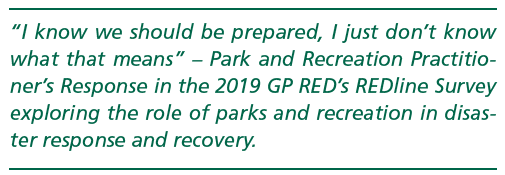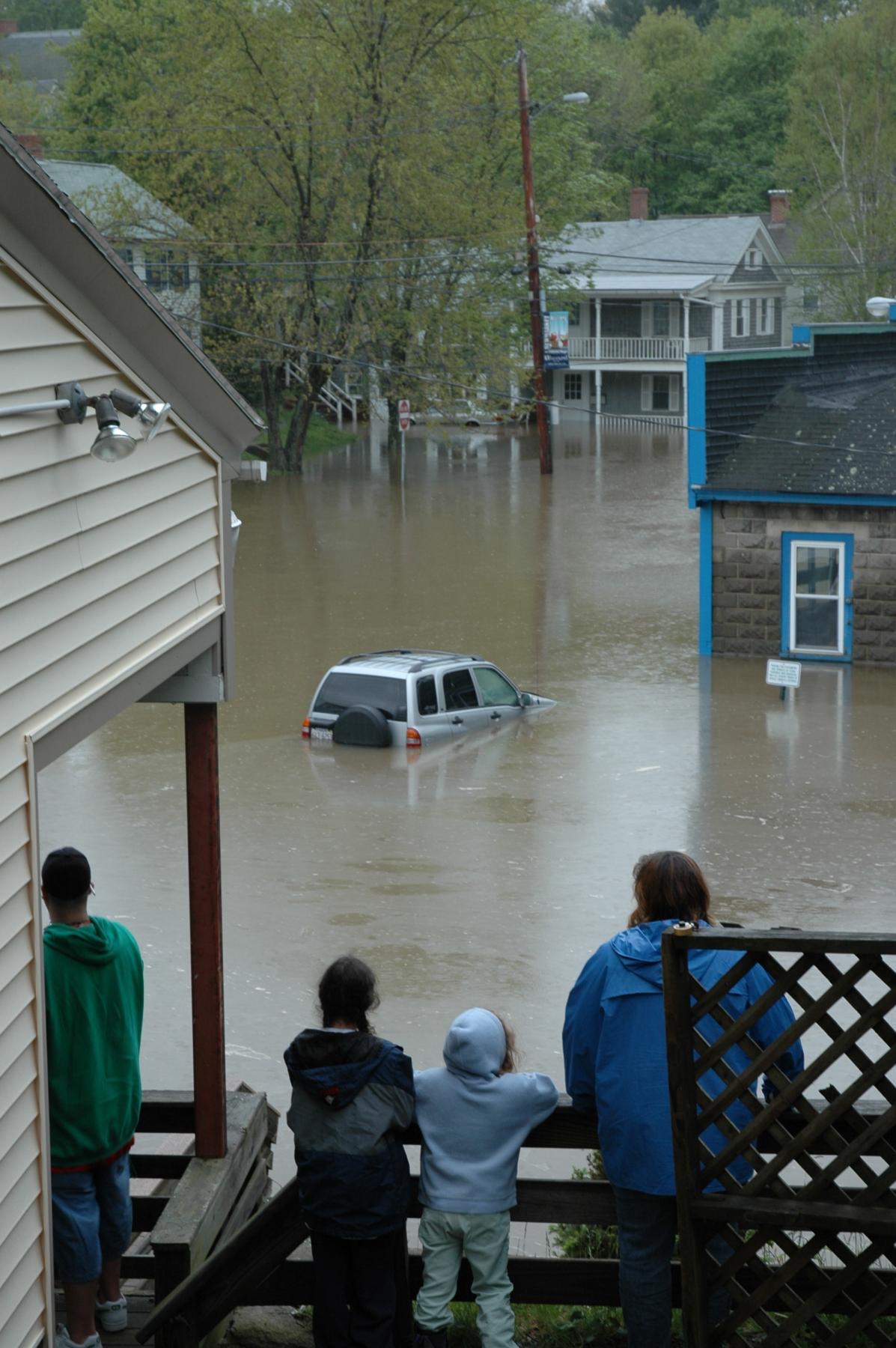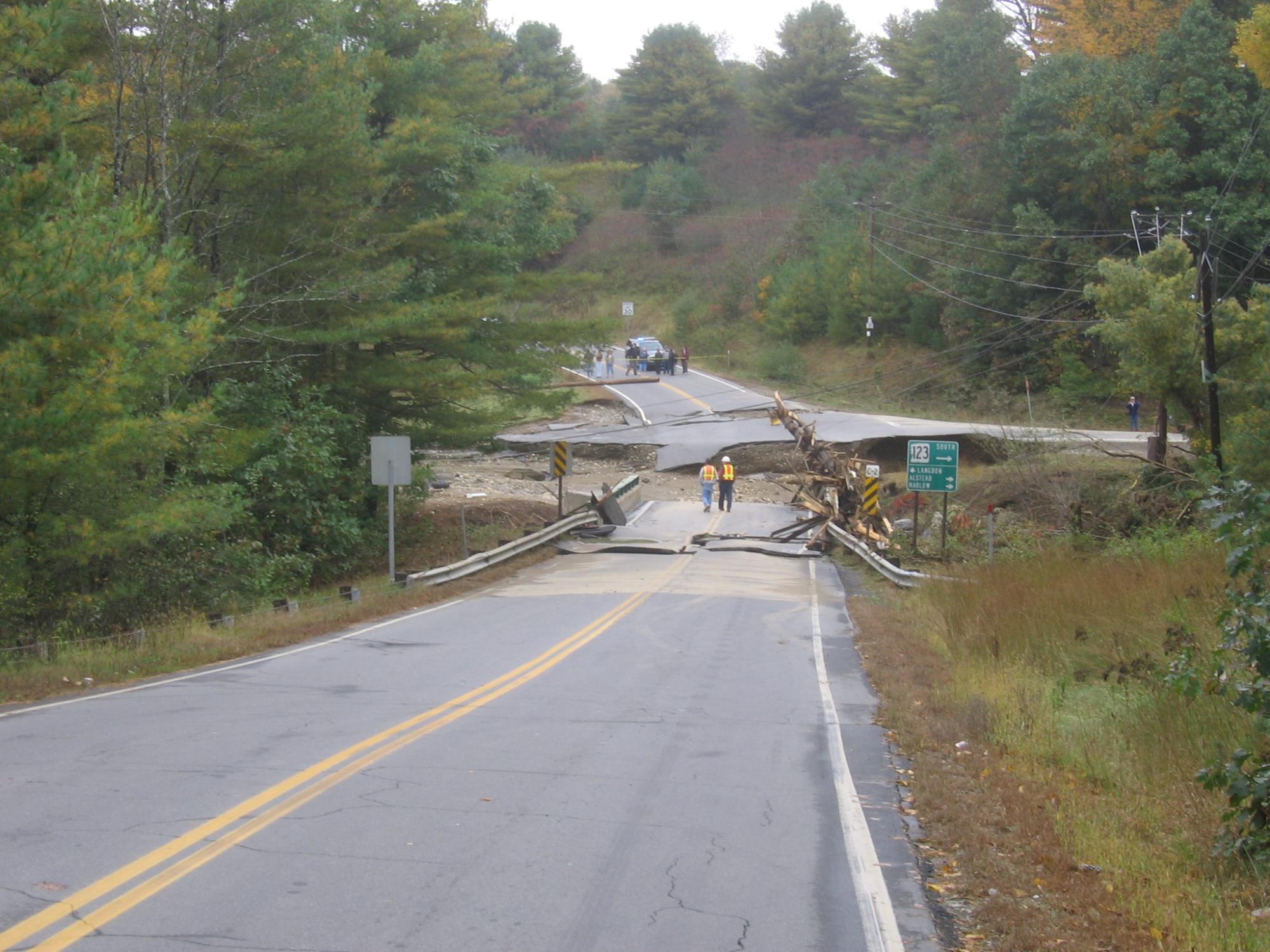The information contained in this article is not intended as legal advice and may no longer be accurate due to changes in the law. Consult NHMA's legal services or your municipal attorney.
Parks and Recreation agencies play a vital role in the physical, economic, social, and emotional health of New Hampshire communities and provide essential community services. Park and Recreation opportunities create the positive quality of life that attracts people to our communities. Following a disaster, the opening or re-opening of recreation facilities as well as the return of recreation services such as youth sports, special events and social programs for seniors, play an important role in the collective mental health and full recovery of a community - often signifying that crucial “return to normalcy.”
Do Recreation practitioners have a role in emergency management and disaster preparation, response and recovery? The answer is “Yes”.
Is your Department Prepared? The first and most important role for Recreation agencies, in terms of Emergency and Disaster Preparedness, is to ensure the Department is prepared.
According to the 2019 GP RED’s REDline Survey, the following conclusions were published: Park and Recreation agencies play a significant role in community disaster and response; the majority who responded had been affected by a disaster, but the majority had not received training or been prepped for disaster or emergency response in the past three years.

Asset Inventory: Best practices recommend Recreation Departments create and maintain up-to-date, detailed, accurate inventories for all properties, facilities, amenities, and equipment. A comprehensive record of what the community had prior to the disaster aids in determining loss, damages, completing required insurance and FEMA paperwork, and reduces the time and work required to get the community restored post disaster. It’s important in obtaining grants that may be available to help restore/replace lost facilities and equipment. Records related to the purchase or lease of property, proof of ownership or right to occupy should be included and are important in obtaining grants.
Long range Planning and Inventory: As part of the inventory process, take a critical assessment of each facility. Is it adequate to meet the long-range needs of the community? If you were to build the facility again what improvements would be made? Perhaps, an athletic field has drainage issues, an indoor facility has inadequate heating systems, or a gym not conducive to current programs? If those were damaged or destroyed, it wouldn’t make sense to re-create space that isn’t meeting the needs of the community. These plans should be included in Strategic, Master and Capital Improvement Plans, well documented and discussed as plans for the Department. Any additional equipment and supplies that may be needed due to an improvement in facilities or additional greenspace created as mitigation measures should also be included.
Emergency Action Plan: Does the department have an Emergency Action Plan in place that includes procedures for emergencies such as fire, lost child, natural and human made disasters? What is the evacuation plan? Where do people meet? Who is designated to ensure everyone has safely exited facilities? Is the plan reviewed and updated regularly and practiced with participants in the facilities? Are contracted instructors, volunteers, seasonal and part time staff included in the plan and in practices? Does it include a communication plan? How are facilities accessed? Where are keys, lock and alarm codes? Who has access? Are there plans for who does what and when? All necessary information must be stored where staff can access it.

Recreation agencies that use school facilities for programs must ensure that staff, instructors and volunteers who use those facilities be familiar with their procedures.
According to GP RED’s Survey referenced earlier, of those responding, 57% had a Park and Recreation Emergency Plan in place; 21% did not and 27% did not know if they did or not. In that same survey, the question was asked if they had received training for an emergency or disaster with the response revealing that only 36% had while 64% had not. If the Recreation Department is not prepared for disaster, the community is not fully prepared.
Who is on your “TEAM” and Whose “TEAM” should you be on? The Recreation Department should be represented on the municipality’s Emergency Management Team. In the REDline survey referred to earlier, in response to the inquiry as to whether or not they were on their municipality’s Emergency Management Team, 46% indicated they were, 21% answering no and 25% did not know.
Aren’t Parks and Rec the fun people? What can they bring to the Emergency Management and Disaster Preparedness table? Much. Recreation personnel have skills and experiences that are valuable assets to their communities in times of emergencies and disasters. They possess multiple levels of training in risk management, emergency preparedness, special event planning, facility operations, human resources, child development, first aid and CPR. Many have advanced training like EMT, Wilderness First Responder and many either are, or employ, lifeguards with professional rescuer experience. Recreation practitioners manage facilities, multiple staff members and volunteers. Park and Recreation facilities are sometimes used as shelters, evacuation meeting points, staging areas etc. Many also manage valuable resources that may be needed like vehicles and equipment, such as busses or vans called to action in evacuations, as well as staff trained and certified to drive them.
Equally important, recreation professionals are well known to community members – seniors, children, families and adults. They may have already established relationships with much of the population. This can be helpful for assistance in house checks, evacuations, sheltering, etc.
In several New Hampshire communities, facilities such as community or recreation centers become the emergency shelters during an event.
In terms of who should be on “Your Team”? In essence, the majority, if not all, of the department’s staff – full and part time, seasonal and, possibly, volunteers should have specific, defined, and practiced roles and duties in emergency plans. Likewise, emergency and disaster response must be part of all trainings such as summer staff, youth sport coaches, lifeguards etc. Although not everyone will need the same training, just about everyone in the department needs training in emergency preparedness and procedures. Consider NIMS – National Incident Management Systems training (FEMA) for those in Recreation leadership.
Special Events as Training Tools – Recreation personnel are experienced in planning, coordinating and managing special events, and, therefore, possess skills and experiences that translate to emergency and/or disaster events. Recreation special events can provide opportunities to practice elements that apply to emergency response and can be used as a training tool. Special events often deal with large groups of people in a variety of settings and may include, providing food, overnight accommodations (think - Family Camp out), registration, transportation, crowd control, traffic control (think - Road Races) and collaboration with multiple municipal departments such as police, EMS and Public Works, developing communication plans as well as collaborating with neighboring communities. Building the relationships, familiarity with procedures and personnel prior to an emergency/disaster is key.
Emergency Shelters – As mentioned earlier, recreation facilities may be used as emergency shelters. These may be run by the municipality or an agency like the American Red Cross. Recreation programs may be interrupted although some may continue while the shelter is in place. Ideally, recreation activities should be provided to individuals in shelter situations – especially for those sheltered for extended periods of time. Recreation providers have the supplies, equipment, knowledge, experience and are background checked to provided safe, fun activities to combat boredom and provide social experiences. Including Recreation personnel and finding space, supplies and time for supervised recreation for all should be included in local shelter plans and accommodations.
Reaching Vulnerable Populations: Recreation personnel can be instrumental in reaching vulnerable populations such as the elderly, children and those with special needs. Recreation staff may have relationships with these populations that other agencies may not – participants in senior programs, children who may not be enrolled in public schools, individuals with disabilities - all may use Recreation facilities or programs. Those relationships are helpful in the response phase of a disaster – such as evacuations and house checks.

Mutual Aid for Parks and Recreation in Disaster - Mutual Aid agreements between municipal jurisdictions are key to response and recovery from disasters. Police, Fire, EMT’s, Public Works, as well as Park Maintenance crews often respond to jurisdictions covered by Mutual Aid Agreements within states or inter-state. Formal Mutual Aid agreements for recreation facilities are often established through Public Works or other entities. However, assistance provided for recreation services has largely been handled less formally, if at all. The suggestion here is that recreation services be included in Mutual Aid agreements.
As referenced above, the return to normalcy signified by the re-opening of facilities and return of recreation programs is key to the healing and recovery process. Including recreation services in mutual aid allows recreation professionals unaffected by the event to assist in the continuation or resumption of programs.
Rebuilding Resilient Communities through Parks and Recreation: Parks, Recreation and Greenspace Planning play an important role in re-building communities for long term resiliency, especially in terms of recovery from hurricanes, floods and wildfires. While wildfires and hurricanes are somewhat rare but not unheard of in NH, there have been significant flooding events – coastal and inland. According to the National Recreation and Park Association in the NRPA magazine article entitled, Parks as a Solution to Climate Change - “Strategically placed and managed parks and natural lands buffer cities from rising seas, coastal storms, inland flooding and wildfires. In addition, FEMA’s Building Resilient Infrastructure and Communities (BRIC) Program incentivizes mitigation projects that include nature-based solutions. An example of this is the Lumberton, NC project that created an 8 mile greenway system in the 100 year flood plain, prone to hurricane flood damage.
Conclusion: Ensuring Parks and Recreation agencies are prepared for, respond to, return to providing recreation services and opening of recreation facilities as soon as possible following a disaster, is crucial to creating community preparedness, response, recovery and resiliency. Recreation practitioner’s commitment is to enhance the quality of life in the communities served. These efforts are most needed when the “quality of life” is at its lowest.
Donna Kuethe is the Executive Director of GP RED – a national non-profit that provides Research, Education and Development for Parks, Recreation, Health, Land Management and Allied Fields. She is the Initiator of the Operation Recreation Response Initiative. Donna retired in 2020 after serving 41 years as the Recreation Director for the Town of Moultonborough.